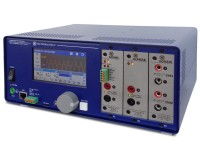EEZ Bench Box 3

DIY modular T&M chassis for programmable power DC sources and more
The EEZ BB3 (short for Bench Box 3) represents the next step in making EEZ H24005 project even more flexible and modular. It is built to simplify adding of new T&M functionalities in the future. During the course of H24005 project we've learned a lot and identify various obstacles and issues caused by different reasons, from inexperience, lack of information, wrong presumption, etc. The process of learning is continued and the EEZ BB3 project is addressing the following issue that we found in the H24005 project:
- We found that the H24005's front panel assembling and disassembling is tedious and difficult task. In the same time it limits modularity since it includes components that really belongs to the module not the chassis (i.e. output terminals, LED indicators, I/O ports). A new level of modularity is achieved by splitting the Digital control board (i.e. Arduino shield) that is mounted on the enclosure front panel back into two parts: the MCU board and the backplane. A module will includes its own front panel that provides access to all parts that have to be exposed (e.g. terminals, switches, LEDs, etc.)
- Move from Arduino Due to more capable solution. The H24005 firmware with its extensive list of functionalities pushed Due to the limits, both in case of computing power and memory capacity. Also, lack of "enhanced" features such as multitasking (like FreeRTOS, etc.) make Due unsuitable in many ways. Therefore STM32F7 is selected as the new platform, but thanks to new modularity it should be possible to choose other MCU, SoC or SBC as main computing power in the future releases.
- Increase total number of modules that was fixed on H24005 to only two. The BB3 offers enough room to host up to three modules. It is slightly higher, but what is important occupy exactly the same benchtop area.
- Bigger screen, and better presentation. Screen size, resolution and speed depends of deployed display controller. Selected new STM32F7 is capable of directly driving displays with RGB interface, reducing the cost of display and simplify HMI programming. The screen size is now increased from 3.2" to 4.3" making more room to comfortably present information and parameters for all three modules. Fonts can be also finally rendered with anti-aliasing make is more legible and improve aesthetics.
With the EEZ BB3 we continue the practice of design in a manner that it can be easily build (or at least doable :) by DIYers/makers with certain level of patience and intermediate skills in soldering, assembling, testing and have basic understanding of software and firmware installations and uploading. Although it includes custom made enclosure, builder has a freedom to make his/her own enclosure or adopt some general purpose enclosure of similar dimensions.
Additionally, when custom enclosure is selected, one can choose to increase the number of peripheral modules by extending its backplane to some higher number (up to 7).
Thanks to modular design, the EEZ BB3 based solution can be build gradually in accordance with ones needs and budget. Peripheral modules can have their own processing resources or can be controlled from master MCU that keeps costs low. The EEZ BB3 can be controlled locally (TFT touchscreen, encoder) or remotely (USB, Ethernet).
Quick facts
- Fully open source
- Modular design (based on DIB v1.0)
- Full range autoswitch AC input (115 / 230 Vac)
- Minimalist wire harness for simplified assembling and servicing
- Up to 3 peripheral modules
- STM32F7 ARM 32-bit MCU
- 4.3” TFT touchscreen display
- Front panel AC power switch
- Incremental encoder and user-defined switch
- USB 2.0 OTG and 10/100 Mbit/s Ethernet connectivity
- Software controlled 80 mm cooling fan
- Remotely controlled by SCPI commands using the EEZ Studio of similar SCPI controllers
- MQTT support
- MicroPython support
- Node-RED integration
- Compact size: 290 (W) x 123 (H) x 240 (D) mm



Updates van de auteur